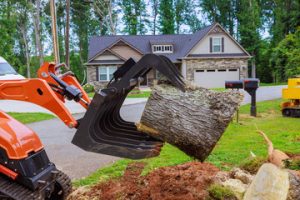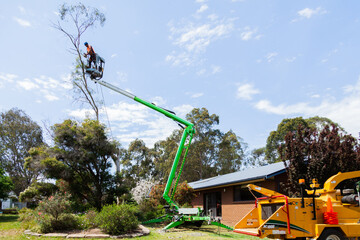Trees are some of the most valuable features of any property. They provide beauty, shade, and environmental benefits that enhance both comfort and value. Yet, there are moments when tree removal becomes not just a choice but a necessity. Whether due to disease, storm damage, or safety hazards, professional Worcester Tree Removal ensure that your property remains secure and well-maintained.

Why Tree Removal Services Are Important
While trees offer countless benefits, unhealthy or poorly positioned trees can cause significant problems. Knowing when removal is necessary can save you from expensive property damage or safety risks.
Here are some of the most common reasons homeowners and property managers turn to professional tree removal experts:
1. Diseased or Dying Trees
A tree infected with fungi, pests, or rot becomes unstable over time. These diseases often spread to nearby trees, threatening your entire landscape. Removing infected trees helps prevent further damage and preserves the overall health of your yard.
2. Storm or Wind Damage
Severe weather can break branches, uproot trees, or leave them dangerously leaning. Emergency tree removal services ensure that fallen or unstable trees are handled safely before they can harm people, structures, or power lines.
3. Structural Interference
Roots and overgrown branches can cause damage to driveways, plumbing lines, and roofs. Removing problematic trees early on protects your property from costly repairs later.
4. Construction and Landscaping Projects
If you’re planning to expand your home, install a pool, or redesign your yard, some trees may need to be removed for safety and space. Professional tree-cutting services ensure efficient clearing while preserving surrounding vegetation.
5. Safety Concerns
Leaning trees, hollow trunks, or decaying roots are warning signs of instability. A professional inspection from a licensed arborist helps determine whether removal is the safest solution.
The Professional Tree Removal Process
Tree removal is far more complex than it might appear. It involves technical knowledge, safety planning, and specialized equipment. Reputable tree removal companies follow a step-by-step process to ensure safe and thorough results.
1. Assessment and Planning
The process begins with a detailed site inspection. Certified tree care experts assess the tree’s condition, size, and location relative to nearby buildings or power lines. This assessment helps determine the best removal method.
2. Safety Setup
Before cutting begins, the team establishes a safety perimeter and prepares all necessary protective gear, such as helmets, harnesses, ropes, and rigging systems. Adhering to strict OSHA guidelines, professionals ensure that everyone on-site remains protected.
3. Tree Cutting and Sectioning
Depending on the situation, arborists may climb the tree to cut it down piece by piece or use cranes for larger specimens. Controlled cutting techniques minimize the risk of damage to nearby structures.
4. Branch and Debris Removal
Once the tree is down, workers clear away all branches, logs, and debris. Many tree removal services recycle or repurpose the wood, offering environmentally friendly disposal options such as mulch or compost.
5. Stump Grinding or Removal
To finish the job, the remaining stump is usually ground down below soil level using specialized equipment. Stump grinding services prevent tripping hazards, discourage pests, and prepare the area for replanting or landscaping.
Why You Should Hire Professionals Instead of DIY
Attempting to remove a tree on your own might seem like a way to save money, but it often leads to higher costs and serious risks. Large trees can be unpredictable, especially when diseased or leaning. Here’s why professional tree removal is always the safer and smarter choice:
- Safety and Liability – Professionals have the training and insurance to manage complex removals safely. If something goes wrong, you’re protected from liability.
- Advanced Equipment – Specialized machinery like cranes and stump grinders ensures efficiency and safety—tools most homeowners don’t own or know how to use.
- Expert Tree Knowledge – Certified arborists understand how to evaluate tree health and determine whether a tree needs pruning, treatment, or removal.
- Efficiency and Cleanup – A professional crew can complete the job in hours, including debris removal, which saves you time and effort.
- Long-Term Landscape Health – Experts consider the impact of removal on the remaining trees and soil, helping maintain ecological balance.
Benefits of Timely Tree Removal
Delaying tree removal when it’s clearly needed can lead to costly damage and safety issues. Here are the top benefits of taking action at the right time:
- Enhanced Safety
- Removing damaged or diseased trees prevents accidents caused by falling branches or collapsing trunks.
- Property Protection
- Trees with spreading roots or heavy canopies can harm driveways, fences, roofs, and plumbing. Timely removal protects your investment.
- Improved Landscape Health
- By removing one unhealthy tree, you allow surrounding plants to access more sunlight, water, and nutrients.
- Increased Property Value
- A well-maintained, hazard-free yard enhances curb appeal and boosts property value—key for homeowners considering resale.
- Storm Preparedness
- Regular inspection and removal of weak trees before storm season helps reduce potential damage during heavy winds or rain.
How to Choose the Right Tree Removal Company
With many options available, selecting the right tree service provider can feel overwhelming. Here’s how to make a confident and informed choice:
1. Verify Credentials
Look for certified arborists or companies licensed to operate in your area. Certification ensures that the team has proper training and follows best practices in tree care and safety.
2. Check Insurance Coverage
Always confirm that the company carries both liability and workers’ compensation insurance. This protects you in the event of property damage or worker injury.
3. Read Reviews and Ask for References
Customer reviews reveal how reliable and professional a company truly is. Look for consistent feedback on safety, efficiency, and communication.
4. Request Detailed Estimates
A trustworthy company will provide a written quote outlining the cost of tree removal, debris cleanup, and stump grinding. Avoid vague or unusually low estimates.
5. Evaluate Equipment and Techniques
The best companies invest in up-to-date machinery and safety equipment. Ask about their methods, especially if the tree is near power lines or buildings.
6. Consider Eco-Friendly Practices
Choose providers that recycle wood, use sustainable disposal methods, and minimize environmental impact during removal.
7. 24/7 Emergency Availability
When storms strike, time is crucial. Emergency tree removal services ensure prompt response and prevent further damage.
Frequently Asked Questions About Tree Removal
How much does tree removal cost?
Costs depend on the tree’s size, health, and location. On average, small tree removal may cost a few hundred dollars, while large or hazardous trees can cost significantly more. Always request a detailed estimate before starting.
Do I need a permit to remove a tree?
Permit requirements vary by city and county. Professional tree removal companies can guide you through the local regulations to ensure compliance.
Can I remove a tree myself?
It’s highly discouraged. Without the right equipment or experience, DIY removal can be dangerous and lead to property damage or injury.
What’s the difference between tree trimming and tree removal?
Tree trimming services involve pruning specific branches to maintain tree health, while tree removal eliminates the entire tree and stump.
Should I remove the stump after the tree is cut?
Yes, stump removal or grinding prevents pest infestations, fungal growth, and regrowth from roots. It also improves your yard’s appearance.
Maintaining a Safe and Beautiful Property
Healthy trees make your property vibrant and inviting, but neglected or unstable ones can become hazards. Professional tree removal services combine skill, equipment, and environmental awareness to maintain the balance between safety and beauty.
Regular inspections by a licensed arborist, along with consistent tree trimming and maintenance, can prevent emergencies before they occur. And when removal becomes unavoidable, relying on tree care experts ensures the process is handled safely, efficiently, and responsibly.
Whether you need affordable tree removal, emergency tree removal, or stump grinding services, partnering with the right professionals keeps your landscape healthy and your property protected.
A well-cared-for yard doesn’t just look good—it keeps your home safe, your trees thriving, and your investment secure for years to come.
